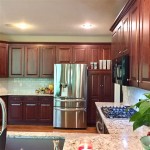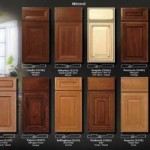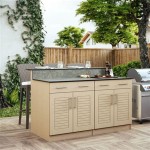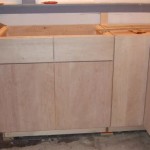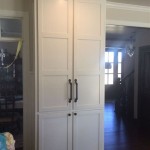Painting Formica Cabinet Doors: A Simple Guide
Formica cabinets, frequently found in older homes and apartments, present a durable and affordable kitchen storage solution. However, their aesthetic appeal can wane over time, leading homeowners to consider replacement. Before embarking on a costly and disruptive cabinet replacement project, consider the possibility of painting. Painting Formica cabinet doors is a cost-effective way to revitalize a kitchen’s appearance and extend the lifespan of existing cabinetry. This guide provides a detailed, step-by-step approach to painting Formica cabinet doors, ensuring a professional and long-lasting finish.
The success of painting Formica hinges on meticulous preparation and the use of appropriate materials. Adhesion is the primary challenge, as Formica is a non-porous surface that resists paint adherence. Therefore, surface preparation is crucial to creating a suitable bonding surface for the paint. Skimping on this stage will inevitably lead to chipping, peeling, and an unsatisfactory finish. This guide emphasizes the importance of proper cleaning, sanding, and priming to achieve optimal results.
Essential Materials and Tools
Before commencing the painting process, gathering all necessary materials and tools is imperative. This preparedness will ensure a smooth and efficient workflow, minimizing interruptions and potential errors. The following list outlines the essential items required for painting Formica cabinet doors:
- Cleaning Supplies: A degreasing cleaner (TSP – Trisodium Phosphate – or a comparable substitute), clean cloths or sponges, and a bucket of warm water are necessary for removing dirt, grease, and grime from the Formica surface.
- Sandpaper: Various grits of sandpaper are required for different stages of preparation. A coarser grit (around 120-150) is useful for initial scuff sanding, while a finer grit (around 220) is used for smoothing surfaces after patching or priming.
- Sanding Block or Orbital Sander: A sanding block provides a flat, even surface for manual sanding, while an orbital sander offers faster and more efficient sanding, particularly for larger surfaces.
- Painter's Tape: High-quality painter's tape is essential for masking off areas that should not be painted, such as hinges, drawer slides, or surrounding walls.
- Primer: A high-quality bonding primer specifically designed for slick surfaces, such as Formica, is crucial for ensuring proper paint adhesion. Look for primers labeled as "adhesion primers" or those explicitly recommended for use on laminate or melamine.
- Paint: Choose a durable paint suitable for kitchen cabinets. Options include acrylic latex paint or alkyd paint. Acrylic latex paints are water-based, easier to clean up, and have lower VOCs (Volatile Organic Compounds). Alkyd paints provide a harder, more durable finish but require mineral spirits for cleanup.
- Paintbrushes and/or Rollers: High-quality paintbrushes and rollers are essential for achieving a smooth, even finish. Consider using a combination of both: a brush for edges and details and a roller for larger surfaces. Opt for a low-nap roller to minimize texture.
- Paint Tray and Liner: A paint tray is necessary for holding and distributing paint evenly onto the roller. Using a paint tray liner makes cleanup easier.
- Drop Cloths or Plastic Sheeting: Protect surrounding surfaces, such as floors and countertops, from paint splatters by covering them with drop cloths or plastic sheeting.
- Screwdriver: Required for removing cabinet doors and hardware.
- Wood Filler (Optional): If the Formica surface has any chips, dents, or imperfections, wood filler can be used to repair them.
- Putty Knife (Optional): For applying and smoothing wood filler.
- Safety Glasses and Dust Mask: Protect your eyes and respiratory system from dust and paint fumes.
Step-by-Step Guide to Painting Formica Cabinet Doors
The process of painting Formica cabinet doors can be broken down into several key steps, each requiring careful attention to detail. Following these steps diligently will increase the likelihood of a successful and visually appealing outcome.
- Preparation: Remove Doors and Hardware: Begin by removing the cabinet doors from their frames using a screwdriver. Carefully detach all hardware, including knobs, pulls, hinges, and any other decorative elements. Store the hardware in a labeled container to avoid confusion during reassembly.
- Cleaning: Thoroughly Clean the Formica Surface: Using a degreasing cleaner (TSP or a comparable substitute) and warm water, thoroughly clean the Formica surface of each cabinet door. Pay close attention to areas that may have accumulated grease or grime, such as the areas around handles and edges. Rinse the doors with clean water and allow them to dry completely.
- Sanding: Scuff Sand the Surface: Sanding is a critical step in preparing the Formica surface for paint adhesion. Use a medium-grit sandpaper (around 120-150) to gently scuff the entire surface of each cabinet door. The goal is not to remove the Formica, but rather to create a slightly textured surface that the primer can grip onto. Avoid excessive sanding, which could damage the Formica.
- Repairing Imperfections (Optional): If the Formica surface has any chips, dents, or imperfections, now is the time to repair them. Apply wood filler to the damaged areas using a putty knife, smoothing it out to be flush with the surrounding surface. Allow the wood filler to dry completely according to the manufacturer's instructions. Once dry, sand the filled areas smooth with fine-grit sandpaper (around 220).
- Dust Removal: Remove Sanding Dust: After sanding and repairing any imperfections, thoroughly remove all sanding dust from the cabinet doors using a clean cloth or a vacuum cleaner with a brush attachment. Ensure that the surface is completely free of dust before proceeding to the next step.
- Priming: Apply a Bonding Primer: Apply a thin, even coat of bonding primer to the entire surface of each cabinet door. Use a high-quality paintbrush or roller to ensure complete coverage. Allow the primer to dry completely according to the manufacturer's instructions. This step is crucial for promoting paint adhesion to the Formica surface. A second coat of primer may be necessary for optimal results, especially if the Formica is dark or glossy.
- Light Sanding (After Priming): After the primer has dried completely, lightly sand the primed surface with fine-grit sandpaper (around 220). This step will help to smooth out any imperfections and create an even better surface for the paint to adhere to. Remove any sanding dust with a clean cloth before proceeding.
- Painting: Apply the First Coat of Paint: Apply a thin, even coat of your chosen paint to the primed surface of each cabinet door. Use a high-quality paintbrush or roller to ensure complete coverage. Avoid applying the paint too thickly, as this can lead to drips and runs. Allow the paint to dry completely according to the manufacturer's instructions.
- Sanding (Between Coats): After the first coat of paint has dried completely, lightly sand the painted surface with fine-grit sandpaper (around 320 or 400). This step will help to smooth out any imperfections and create a better surface for the second coat of paint. Remove any sanding dust with a clean cloth before proceeding.
- Painting: Apply the Second Coat of Paint: Apply a second thin, even coat of paint to the cabinet doors. This coat will provide additional coverage and durability. Allow the paint to dry completely according to the manufacturer's instructions. A third coat may be necessary for optimal coverage, especially if you are using a light-colored paint over a dark-colored surface.
- Reassembly: Reattach Hardware and Doors: Once the paint has completely dried, carefully reattach the hardware (knobs, pulls, hinges, etc.) to the cabinet doors. Then, rehang the cabinet doors onto their frames using a screwdriver.
Achieving a Professional Finish: Tips and Considerations
While following the step-by-step guide is fundamental for a successful paint job, incorporating specific techniques and paying attention to certain considerations can significantly enhance the final outcome. These tips can elevate the project from a simple refresh to a professional-looking upgrade.
- Proper Ventilation: Ensure adequate ventilation throughout the painting process. Open windows and doors, or use a fan to circulate air. This is particularly important when using alkyd paints, which have stronger fumes.
- Thin Coats: Apply multiple thin coats of paint rather than one thick coat. This will help to prevent drips, runs, and uneven coverage.
- Edge Detailing: Pay close attention to the edges of the cabinet doors. Use a small brush to carefully apply paint to the edges, ensuring that they are fully covered.
- Roller Technique: When using a roller, avoid applying excessive pressure. Roll the paint on in smooth, even strokes, overlapping each stroke slightly to prevent streaks.
- Brush Strokes: When using a brush, work in the direction of the wood grain (if any). Use long, even strokes to minimize brush marks.
- Curing Time: Allow the paint to fully cure according to the manufacturer's instructions before putting the cabinet doors back into heavy use. Curing time can vary depending on the type of paint used.
- Quality Materials: Invest in high-quality materials, including primer, paint, brushes, and rollers. The use of superior materials will contribute to a more durable and aesthetically pleasing finish.
- Practice: If possible, practice painting on a scrap piece of Formica before painting the cabinet doors. This will allow you to get a feel for the paint and the techniques involved.
- Patience: Painting Formica cabinet doors is a time-consuming process. Be patient and take your time to ensure that each step is completed properly. Avoid rushing, as this can lead to mistakes and a less-than-desirable outcome.
By meticulously following these steps and incorporating these tips, homeowners can successfully paint Formica cabinet doors and transform their kitchens without incurring the expense and disruption of a full cabinet replacement. The renewed cabinets will add value and refreshing style to their homes.

How To Paint Laminate Cabinets Without Sanding The Palette Muse

How To Paint Kitchen Cabinets Without Sanding Or Priming

Diy Painting Your Kitchen Cabinets The Right Way

3 Ways To Paint Laminate Cabinets Wikihow

How To Paint Laminate Cabinets Without Sanding The Palette Muse

How To Paint Cabinets

How To Paint Oak Cabinets And Hide The Grain Tutorial

The Best Way To Paint Kitchen Cabinets No Sanding Palette Muse

How To Paint Laminate Cabinets Without Sanding The Palette Muse

How To Make Diy Cabinet Doors Without Fancy Router Bits
Related Posts

